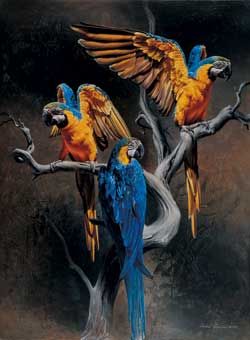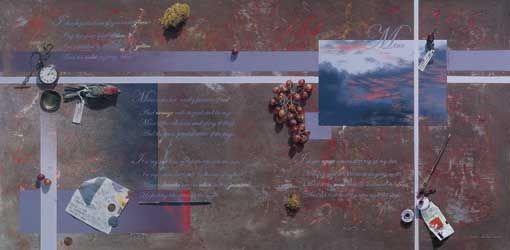
By Bonnie Gangelhoff
Precocious. What else do you call a 13-year-old who walks into an established art gallery and asks the owner to represent him? California painter Andrew Denman is the first to agree that he possessed sheer, unadulterated moxie in 1992 when he inquired, in earnest, if Dennis Salvo of Pacific Wildlife Galleries in Lafayette, CA, would show his colored-pencil drawings.
Salvo recalls the encounter with amusement. “I politely said no to him at first—I mean, I carry Robert Bateman,” he says with a laugh. “But Andrew kept coming back and coming back and coming back. I have never seen anyone so determined and focused in my life. At that age, he already knew he wanted to make a living at art. And, sure enough, he is.”
Some observers might say that Denman is still precocious and traveling along an unusually swift career track. At 27, he is among the youngest members of the Society of Animal Artists, and he has participated in the prestigious Birds in Art show at the Leigh Yawkey Woodson Art Museum in Wausau, WI, for the past two years. His works are currently on view along with those by a cadre of established artists in The Art of Seeing: Nature Revealed Through Illustration at the Oakland Museum of California.
Growing up in San Francisco’s East Bay area, Denman doesn’t remember a time when he wasn’t interested in art or animals. In school, he says, there was the math genius, the science nerd, and him: “I was the art guy,” he recalls. In high school, Denman organized his first one-man show at the public library in Orinda, his hometown. Wild Images: Past, Present, and Imagined boasted works depicting everything from frogs to dinosaurs.
Adults gradually took notice of him. Teachers praised him as a brilliant young artist. “While all that was ego-gratifying, it didn’t help hone my skills,” Denman says. It was Salvo he turned to for advice and constructive criticism. When the gallery owner suggested he switch from pencil to acrylic during high school, Denman heeded the counsel and found that the medium suited his artistic vision.
Salvo eventually agreed to represent the young artist. Since Denman graduated from St. Mary’s College in Moraga, CA, in 2000 with a degree in fine art (first in his class), the gallery has presented three one-man shows of his work and sold more than 30 paintings each time. “I tell everyone Andrew is the Tiger Woods of wildlife art,” Salvo jokes.

What fascinated Denman as a boy still holds his creative attention—art and wildlife. “For me, when I see an animal that interests me, the way light glints off an eyeball, the softness of some feathers, or the exotic color of plumage, my first impulse is to want to share it with people,” Denman says. “I think most artists are drawn to or inspired by things they see.”
But what often surprises him is how little the general public seems to take notice of the natural world. Life these days moves at such an incredible pace, he theorizes, that people rarely slow down to look at the crow sitting on the traffic light or the squirrel racing across their back yard. For Denman, portraying birds, squirrels, and even chimpanzees in a painting has the potential to elevate the way people see these creatures. “By putting animals in a framework of fine art, it makes people take notice,” he says. “It can force them into a more observant mode when they are out in the real world.”
Ask Denman a steady stream of questions about his work and life, and he fires back answers that demonstrate he has given serious thought to a host of issues concerning nature, art, and his philosophy. But the one question that stumps him is this: How would you describe your style of painting? “I’ll have to think about that one,” he replies. He pauses here perhaps because his style is still evolving and encompasses such a unique variety of genres, subject matter, and compositions. It comes as no surprise when he eventually shares a long list of diverse artists who inspire and influence him, including contemporary wildlife painters Ray Harris-Ching and Robert Bateman, abstract expressionists Mark Rothko and Barnett Newman, and trompe l’oeil masters William Harnett and John Haberle.
Unlike many artists who move from one style to another over the course of a lifetime, Denman consciously embraces overlapping styles simultaneously. While early in his career he may have seen himself as a representational painter, his works today regularly feature abstract elements, as in the 2003 painting indigo. The depiction of three peacocks is pivotal in his oeuvre because, Denman says, it was the first piece in which he allowed abstraction to enter the subject itself and not just the background. (indigo was also the piece that gained him entry into the Birds in Art show for the first time in 2004.)
The idea behind indigo was to highlight the process of painting, Denman explains. From foreground to background, the birds go from highly detailed and realistic to abstracted and even unfinished. The peacock in the foreground is clearly defined, but the tail of the peacock in the background is far less detailed than the others. To achieve this effect, Denman employed a palette knife to create a thick impasto, then carved back into the chunky paint with the tip of the knife. As with many of his pieces, he then covered the whole painting with several coats of gesso and sanded it. For Denman, the shift in styles from bird to bird is as active and appealing a movement as the “bobbing walk of the birds themselves,” he says.
In the layabout, an intimate portrait of a mountain lion, Denman again mixes styles—the loose treatment of grasses in the foreground blends with a more representational rendering of the animal. While Denman favors observing and photographing animals in the wild and then completing pieces in his studio, he discovered the mountain lion on a visit to the Lindsay Wildlife Museum, an animal rehabilitation center near his home. The cat, he learned, was born in captivity to an owner who declawed it and kept the creature manacled inside a small cage. The mountain lion was eventually rescued but will probably never be released into the wild. “The poor thing—it never had an opportunity to hunt, and it’s not even remotely a candidate for release,” laments Denman, a self-described naturalist, conservationist, and animal lover.
In paintings such as mine is…, Denman commingles the wildlife and still-life genres. The work features a dead bird, an antique pocket watch, a bunch of grapes, and a paintbrush set against a muted wash of background colors that is a close cousin to abstract expressionism in style. Not only does the work illustrate Denman’s interest in mixing genres and styles, it’s also an example of his artistic concern with symbols and words. The words in the background of the piece are from a poem he wrote titled “Second Epiphany,” which deals with the interconnectedness of life and death.
Trompe l’oeil-style depictions of handwritten notes also inhabit mine is…, a personal nod to his habit of taking a zillion notes but never reading any of them, Denman says. But the piece is greater than the sum of its parts. It is a complex rumination on the relationship between good and evil, life and death, and man and nature, he explains. That meaning comes in part from the painting’s pocket watch, a family heirloom that has been passed from generation to generation, accompanied by a story about two brothers, Denman’s great-uncles. The story goes that one brother, Fred, was sick with the flu during the influenza pandemic of 1918 and 1919, and asked the other, Cecil, to fetch him some ice cream. When Cecil returned, Fred had died. He kept Fred’s watch as a memento, and the timepiece was passed down in the family until Denman’s grandmother gave it to him. “It’s a sweet and sad story about the fragility of life,” he says.
In glide, Denman paints the word itself onto the canvas, using curling, fluid strokes that seem to illustrate the meaning. The word also describes the movement of the moorhen depicted in the piece. The large areas of negative space surrounding the bird evoke an Asian sensibility, reminiscent of both ancient and contemporary Japanese brush painting in which logograms (signs, symbols, or characters) are used to represent entire words. Denman hopes the piece conveys the same sense of calm and peacefulness he experienced while watching the bird float across a quarry lake near his home.
It goes without saying that the idea of capturing animals detail-for-detail holds no interest for Denman. “I would rather paint the world not necessarily 100 percent as it is, but as I see it,” he explains. The artist prefers to borrow, blend, and constantly imagine new ways of presenting his subject matter. He’s not opposed to covering old ground, he asserts, he just wants to create with innovation.
Denman is convinced that viewers who prefer traditional depictions of wildlife as well as those who favor more modern renditions can all reap enjoyment from his eclectic images. What’s important to him is that they understand the “feelings and emotions that my encounter with the subject inspired in me,” he says. “I want people to have some inkling that I’m an artist first and a naturalist second.”
When asked about where he wants his art to take him in the future, Denman quips, “If I knew that, it wouldn’t be any fun getting there.” Then he adds, with typical determination: “I will continue to be open to experiment and fight the urge to edit myself. And in so doing, I hope whatever direction I am meant to develop I will explore unimpeded and uninhibited.”
Denman is represented by Pacific Wildlife Galleries, Lafayette, CA.
Featured in April 2006





